
by Beth Bolles | Oct 23, 2025
One of our well known spiders found in landscapes is the Yellow and black garden spider, Argiope aurantia. Most people will recognize this beautiful spider that rests in a large web with a zigzag web pattern in the middle called a stablementum. A wide variety of insects will be caught in the web throughout the summer, with many prey larger than the spider itself. The Yellow and black orb weaver is just one of our beneficial spiders in landscapes.
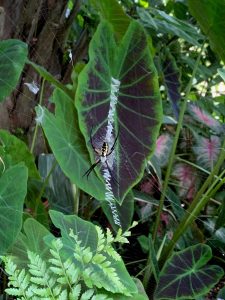
Garden spider waiting for a meal. Photo by Beth Bolles, UF IFAS Extension Escambia County.
As fall approaches each female garden spider leaves us a wonderful gift in the garden. She will create a very distintive egg sac that can be hidden in plants or hang in the corner of a porch. The sac is brown and pear shaped, supported by strands of web attached to branches or structures. Hundreds of eggs are inside and although they hatch in late fall, the spiderlings will stay in the sac until the spring. A large number of spiderlings will not survive due to predation and other factors, but a few will continue development to adorn your garden in the following season.
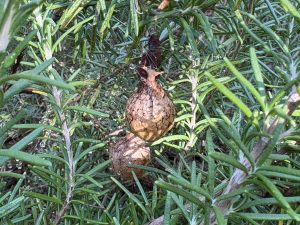
Egg sacs of the Yellow and black garden spider in a rosemary. Photo by Beth Bolles, UF IFAS Extension Escambia County.
If you did have a garden spider in your landscape this summer, just be a little more careful when maintaining plants. You don’t want to accidently remove the overwintering egg sac. Although this large spider can be startling for many people, they are not aggressive and are considered beneficial in the garden.
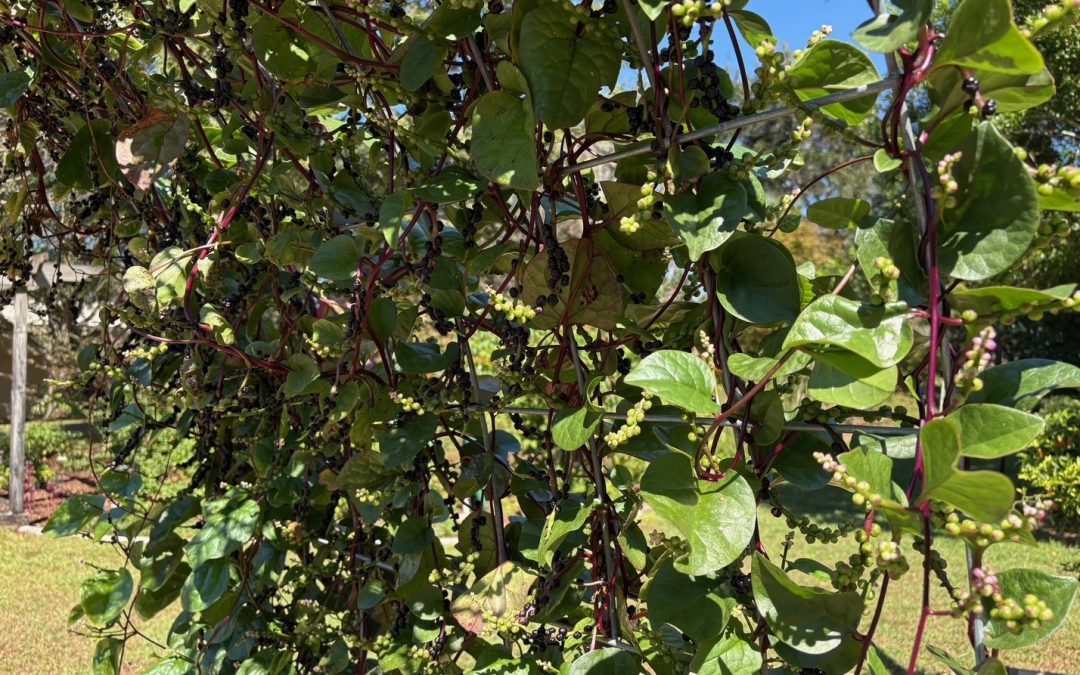
by Beth Bolles | Oct 17, 2025
Saving seeds is a wonderful garden activity that gives us both a sense of pride in our gardening skills and helps us save a few dollars on new seeds.
Malabar spinach is one of our heat loving vines that grows well until frost and produces abundant seed. If you are looking for a leafy green spinach substitute, Malabar spinach does very well in the summer garden. We had a late start on planting our Malabar spinach in the Escambia Extension garden so the seeds are now ripening. This is the perfect plant for saving seeds.
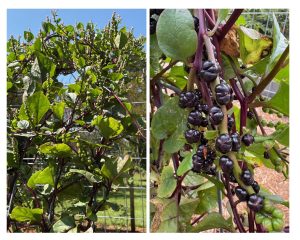
Vines growing along with mature fruit. Photos by Beth Bolles UF IFAS Extension Escambia County.
Malabar spinach has plenty of fruit for you to save seeds for yourself and friends. When mature, fruit will be dark purple and you may easily pull the fruit off stems into a small container. This is definitely a practice that requires gloves unless you want to have your hands stained purple for a while.
Your next step is to lightly press on the fruit while running them under water. Have a strainer underneath to catch the fruit. You are just trying to loosen some of the pulp, not remove every bit. Fill a small jar 3/4ths with water and then add your fruit. Let this sit on a counter for a few days. You may change out the water as needed. This is the step that loosens the remaining pulp from around the seeds.
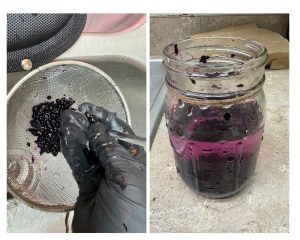
Loosening pulp from seeds and then soaking in water. Photos by Beth Bolles, UF IFAS Extension Escambia County.
After several days in the jar, pour the jar liquid through a strainer and wash over it with clean water. This removes the final bits of pulp. Place a paper towel or cloth on the counter and lay out your cleaned seeds. They will need to air dry for a couple of days. Keep seeds away from a heat source and out of the sun.
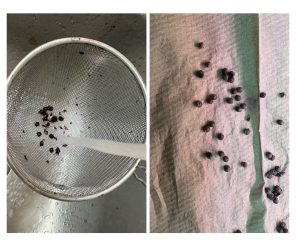
Final rinse of seeds and drying on towel. Photos by Beth Bolles, UF IFAS Extension Escambia County.
Once dry, you are ready to package your seeds for next season’s planting or gifts for friends. You may use a paper envelope or small plastic bag. You may also add seeds to a jar, close it tightly, and put in the refrigerator. Label your package with the plant and date because you will not remember those details later.
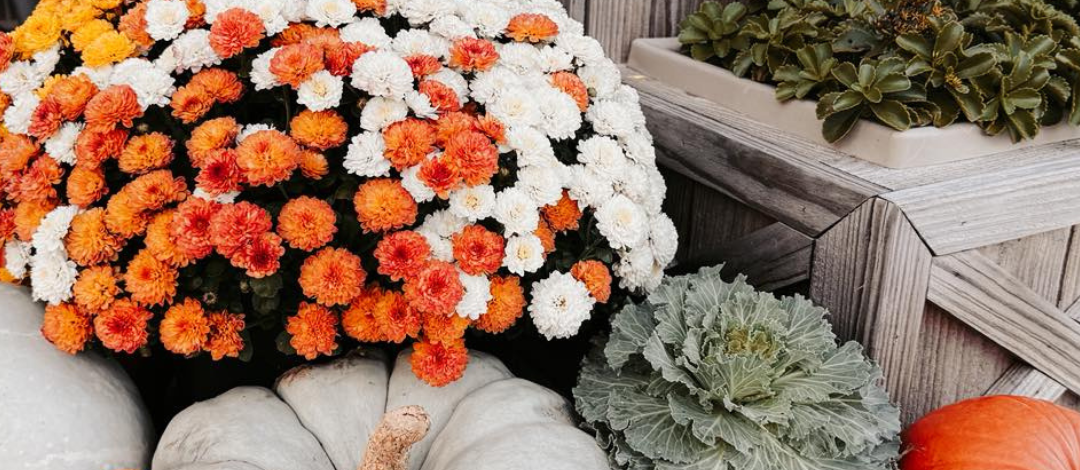
by Abbey Smith | Oct 17, 2025
If you have walked through any retail garden centers lately, you probably have seen some bright colored fall flowers. These pretty plants are what we call mums, or chrysanthemums. Mum flowers are a fall staple in the south to see on a front porch or any fall decorated scape. They pair great with an heirloom pumpkin or some ornamental kale. Growing up in Kentucky, mums are everywhere you turn this time of year. But how can you make the most of your mums this fall? Follow along for great tips to keep your mums fresh for the next several weeks.
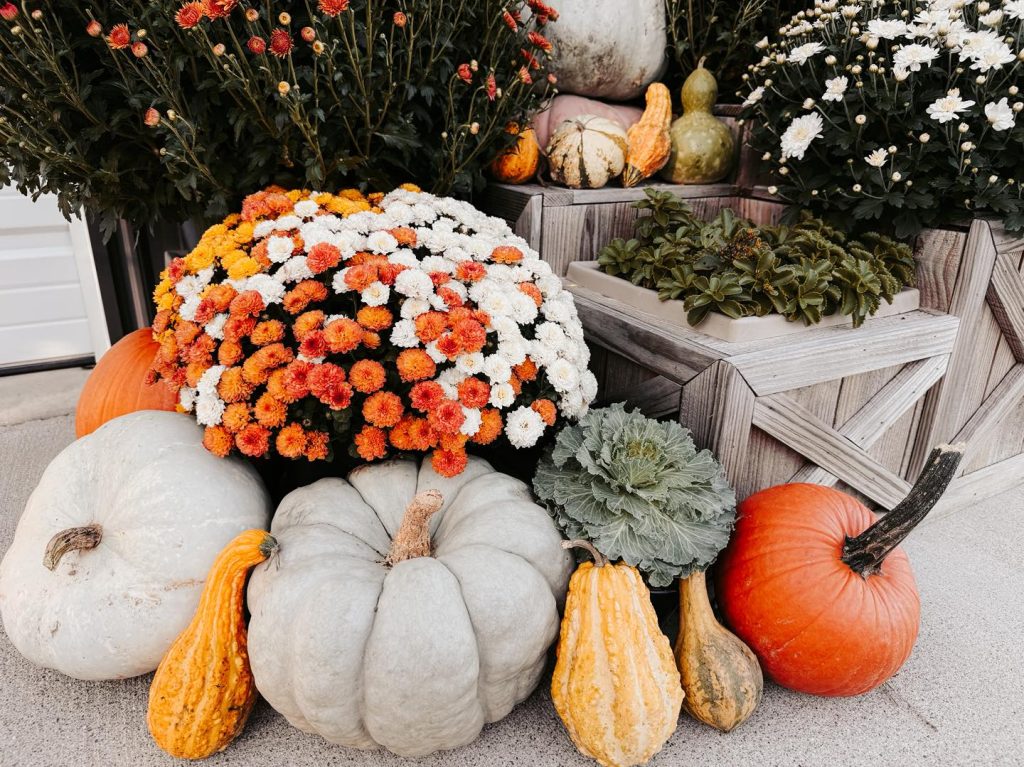
Mum Fall Design. Photo Credit: Danielle Allen, Glory Goods- Irvington, KY
When shopping for the perfect mum for your porch, it is best to try and select a pot that has not fully bloomed yet. Chrysanthemums come in a variety of colors and some varieties even bloom more than one color (I love Candy Corn Mums!), but it is crucial to choose a plant that is not showing any color at all yet. The more blooms, the less life span you will get. Many wholesale mum growers will “de-head” the blooms or remove the buds appearing closest to opening when they are closer to market time to keep the inventory prettier for the consumer. It’s also important to select plants that look healthier. Mums bloom in a mounding fashion, so having uneven bloom patterns or discoloration is not a good sign. It’s also good practice to remove blooms as they begin to die off to make room for new ones.
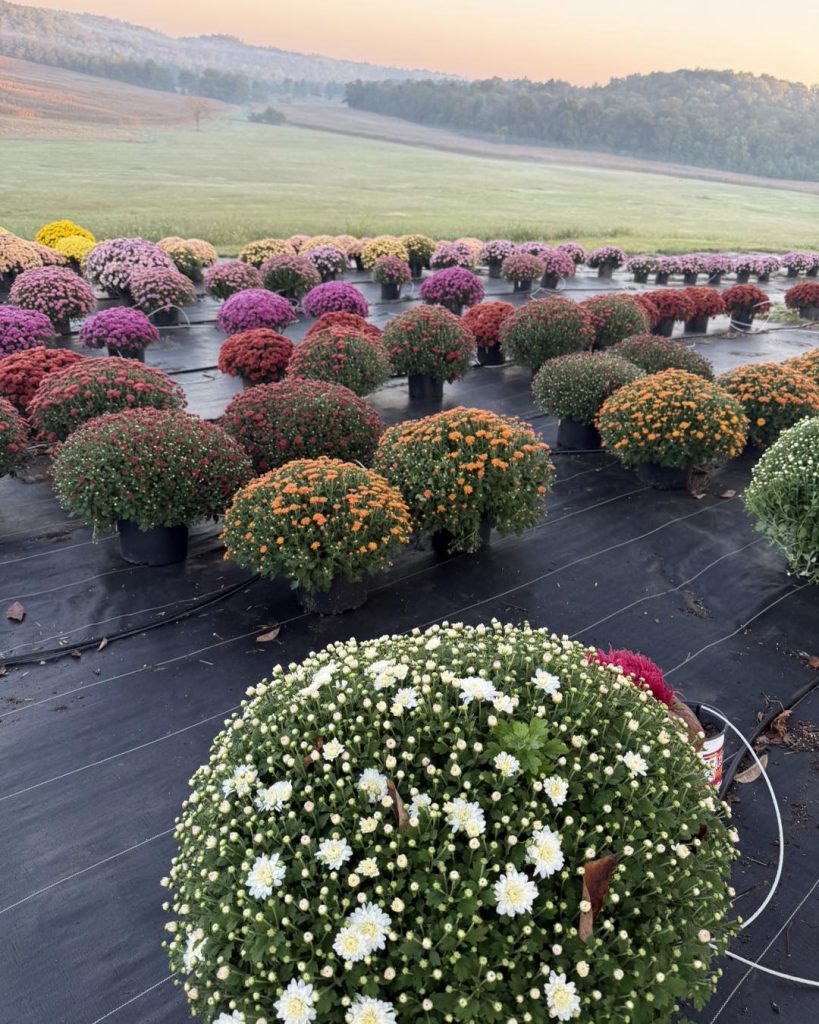
Glory Goods Mum Wholesale Growing Pad. Photo Credit: Danielle Allen, Glory Goods- Irvington, KY
In the last several weeks in Jackson County there has been little to no rain fall. It’s important during dry spells like these to keep your mums saturated but not sopping wet. Mum flowers love to be watered from the bottom. To do this, set the pot in a bucket of water no longer than 15 minutes at a time to allow the soil to hydrate thoroughly. Watering your mum from the top can increase chances of bacteria and fungus growing on your blooms and can cause uneven blooming patterns. Mums need full sun to grow, so monitoring their dryness is important so your plants don’t dry out completely.
Okay, so Halloween is over, you hear the turkey gobbling, and Santa’s sleigh is on the horizon; this doesn’t mean throw out your mums! You can easily keep your mums in containers until December, but there is a risk of frost. When the temps drop below 40 degrees Fahrenheit at night, covering mums with old towels or sheets and removing them in the morning is best practice to keep your blooms frost-safe. You can also plant your mums in the ground. If you chose to do this, it is best to amend with compost as most mums are not acclimated to sandy soil.
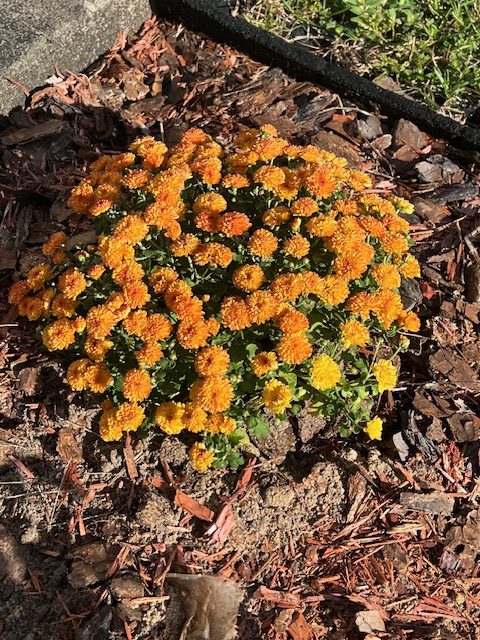
Mum in the Ground. Photo Credit: Abbey Smith, UF/IFAS Extension
For more information, please visit:
https://gardeningsolutions.ifas.ufl.edu/plants/ornamentals/chrysanthemums/
https://nwdistrict.ifas.ufl.edu/hort/2024/10/17/mums-the-word-on-fall-color/
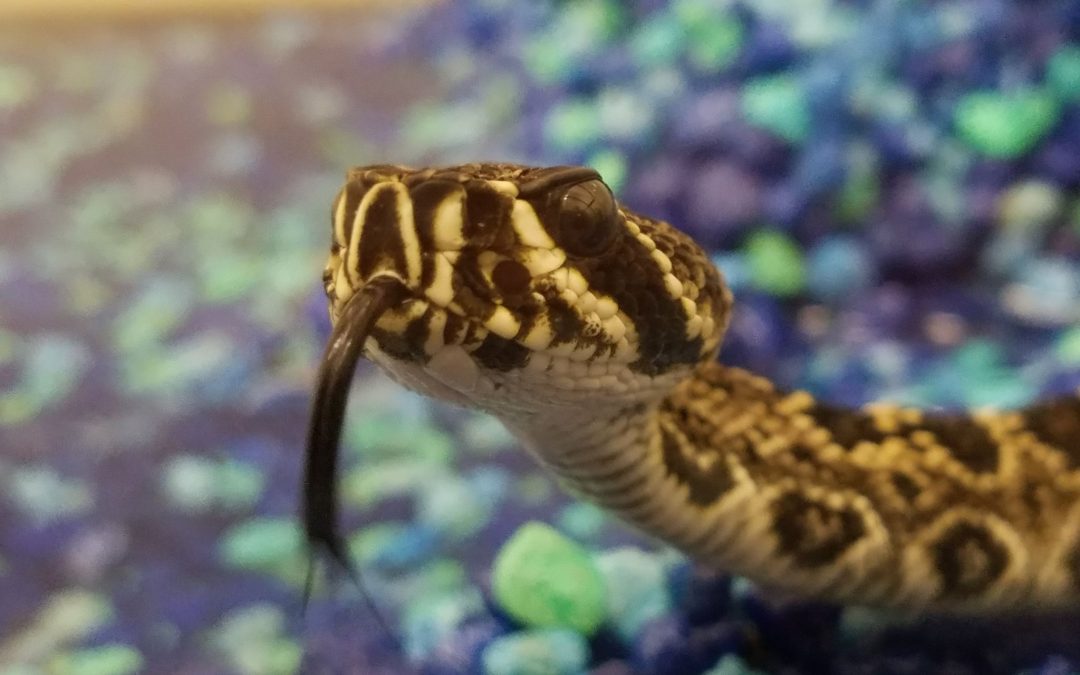
by Evan Anderson | Oct 10, 2025
Snakes of the Panhandle
Love them or hate them, snakes are a common sight in the Florida panhandle. It can be tempting to lump all snakes into the category of ‘kill it on sight!’, but that approach isn’t the best. They can be harmful or beneficial – nobody wants a snakebite, venomous or not, but snakes can play a valuable role in the ecosystem, keeping rodent populations under control.
Plenty of the snakes we have in the panhandle are harmless to humans. Only six species in the panhandle are venomous, and not all are found across the entirety of the panhandle. There are plenty of other nonvenomous snakes, some of which may resemble dangerous ones.
Some of the most common nonvenomous snakes include:
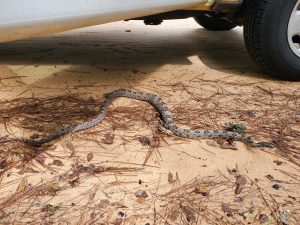 Rat snakes – Harmless, unless you’re a mouse or rat, the gray rat snake is also referred to as an oak snake. Very common and sometimes bred in captivity, especially red rat snakes.
Rat snakes – Harmless, unless you’re a mouse or rat, the gray rat snake is also referred to as an oak snake. Very common and sometimes bred in captivity, especially red rat snakes.
Black racers – One of the more commonly spotted snakes in the daytime, black racers live in urban and suburban environments. Adults are black with a white chin, feeding on rodents, lizards, frogs, birds, or even other snakes.
Ringneck snakes – Common but reclusive, the ringneck snake is small, black on top with a bright yellow underside that changes to orange near the tail. A distinct yellowish ring on its neck gives it its name. Not venomous, and does not bite.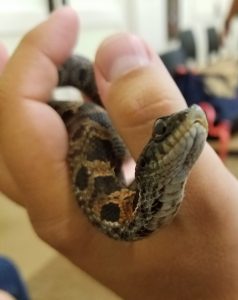
Hognose snakes – Living in dry, sandy habitats, hognose snakes are relatively small, with a distinctive upturned nose. They use this nose like a shovel, burrowing after the toads they feed on. Harmless to people, they try to appear threatening when disturbed and switch to playing dead if that doesn’t work.Garter snakes – Variable in color, but often with long stripes running the length of their bodies. Found near water, garter snakes may try to bite or release a foul smelling musk if captured. They are not venomous, however.
Water snakes – Several species of nonvenomous water snakes call the panhandle home. They live near ponds, lakes, canals, rivers, creeks, and other fresh water bodies. Most will try to bite if handled, and release foul smelling musk as a defense. They usuall feed on small fish, frogs, or sometimes small invertebrates.
King snakes – Looking very similar to the venomous coral snake, the scarlet kingsnake is not dangerous itself. It is small and likes to burrow, feeding on small lizards and rodents. It has bands of red, black, and white or yellow, but the red and white (or yellow) do not touch.
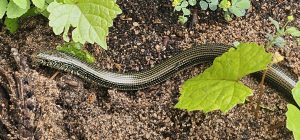 Glass lizards – Active during the daytime, these are legless lizards rather than actual snakes. Their name refers to their ability to detach their tails when in danger. The tail continues to wriggle, distracting predators while the lizard itself escapes. They eat a wide variety of insects, small creatures, eggs, and even smaller glass lizards.
Glass lizards – Active during the daytime, these are legless lizards rather than actual snakes. Their name refers to their ability to detach their tails when in danger. The tail continues to wriggle, distracting predators while the lizard itself escapes. They eat a wide variety of insects, small creatures, eggs, and even smaller glass lizards.
The varieties of venomous snakes found in the Florida panhandle are:
Pygmy rattlesnakes – Small, well camouflaged in the pine forests it inhabits, pygmy rattlesnakes are aggressive. They do have a rattle, but the sound they make is a quiet buzz more like the sound an insect might make. They normally eat frogs or other small creatures, and while a bite is unlikely to be deadly to a human, it can be painful and cause infection.
Canebreak or timber rattlesnakes – A larger rattlesnake, these can grow up to six and a half feet in length. They prefer to flee rather than fight, but can be potentially lethal if they do bite.
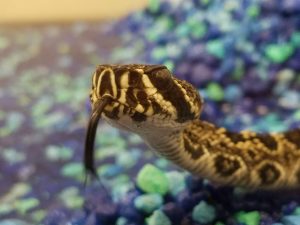 Diamondback rattlesnakes – As its name suggests, it has diamond-shaped patches along its back. Growing up to eight feet long, the diamondback rattlesnake can be dangerous and should not be approached within six feet, as it can strike quickly up to half its body length away. Thankfully, it is not particularly aggressive unless approached, and tries to warn off intruders with its rattle which produces a loud warning buzz.
Diamondback rattlesnakes – As its name suggests, it has diamond-shaped patches along its back. Growing up to eight feet long, the diamondback rattlesnake can be dangerous and should not be approached within six feet, as it can strike quickly up to half its body length away. Thankfully, it is not particularly aggressive unless approached, and tries to warn off intruders with its rattle which produces a loud warning buzz.
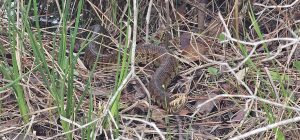 Cottonmouths or water moccasins – Found near water, the cottonmouth is named for its habit of opening its mouth, which has a whitish lining, as a threat. It may not flee when approached, and can strike aggressively. Its bite is potentially lethal.
Cottonmouths or water moccasins – Found near water, the cottonmouth is named for its habit of opening its mouth, which has a whitish lining, as a threat. It may not flee when approached, and can strike aggressively. Its bite is potentially lethal.
Copperheads – Only found in a few specific parts of the panhandle, the copperhead is marked with alternating bands of light and dark brown. Juvenile cottonmouths often resemble copperheads. The copperhead often hides beneath logs or in wood piles, and is well camouflaged amongst piles of leaves. The bite is very painful.
Coral snakes – Seldom seen, but very venomous. Coral snakes can grow to sizes of up to four feet in length, and are colored with bands of red, yellow, and black. The red bands touch yellow ones, unlike on the king snake. Coral snakes are not particularly aggressive and prefer to flee, but its venom is a potent enough neurotoxin to make caution very much advised.
Snake bites are not common, and fatalities from them are less than ten annually in the United States. Wear appropriate clothing when in wild areas, and watch where you step. Do not approach wild snakes, and do not handle freshly killed snakes. In case of a snakebite, call 911 immediately, even if symptoms are delayed. Do not risk further bites in an attempt to identify the snake – stay away! Immobilize the bitten area and keep it lower than the heart, and do not apply suction, ice, heat, or a tourniquet. Do remove tight clothing or jewelry near the bite. Note the time of the bite, what symptoms occur, and any first aid given to the victim so first responders have all the information they need.
Evan Anderson
Walton County Horticulture Agent
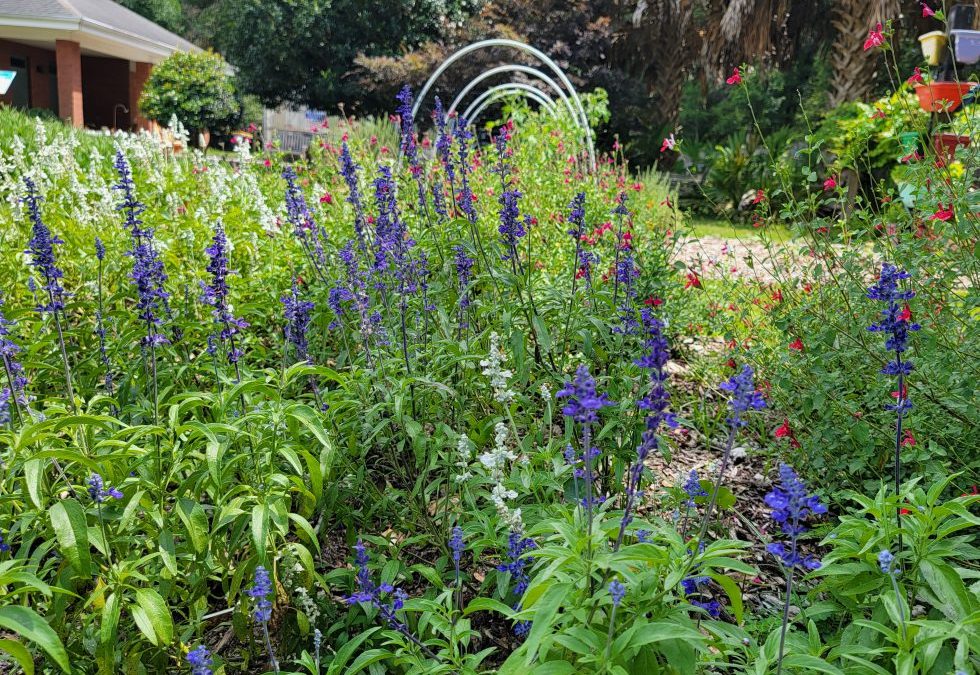
by Joshua Criss | Oct 10, 2025
Planning landscaping is undoubtedly not easy. The primary concern relegated to each individual homeowner is what you want out of your yard. Many are content with just grass, while others desire a diverse array of plant life. One aspect oft overlooked is your landscape’s capacity to be a boon for local wildlife. With a bit of planning, your property could be literally buzzing with insect pollinators, wild birds, and even our reptilian friends.
Where to Start
For this article, let’s begin with a newly established development. What has happened in this scenario from an ecological perspective, with what we’d call primary succession? In short, this means an area that experienced a complete reset of its plant communities. In nature, this would be the result of events such as a volcanic eruption, but in Florida, it’s far more likely due to bulldozers.
Now, the good news in this scenario is that you won’t be receiving your property in this condition. The developer has fast-tracked the process by planting grasses and some basic trees by the time you’ve purchased the property. It’s from this basic setup that you, my new homeowning friends, can begin your husbandry of our local animals.
Begin by investigating the where your new home was built. If it began as a wetland, you’ll want to select plants appropriate for that environment. The same is true if you’ve moved into what was forest land. This thought aligns directly with the first of our FL Friendly Landscaping principles: right plant, right place. There is little sense in putting plants that don’t like wet feet into a poorly draining soils common in wetlands.

UF/IFAS Photo: J. Criss
Consider Your Environment
You’ll also want to investigate the wildlife that is endemic to those environments and areas. Knowing what is there, and what you’d like to attract to your landscape, will help you decide which plants will be best. For instance, replacing a crape myrtle (Lagerstroemia indica) with a red maple (Acer rubrum) in what was previously a wetland environment puts a tree better suited to that environment, which will require less maintenance from the homeowner. Additionally, red maples are known to be an early-season nectar source for a multitude of moths and butterflies while providing nesting sites for local birds.
Red maples are a great example of plant selection and what it can do to attract wildlife to your yard, but there are other guidelines with which you’ll want to be familiar should this be your goal.
Guidelines for Attracting Wildlife
Water is critical to all life on the planet, including wildlife. Providing water features in your garden will increase the chance for animals visits to your garden. This can be as basic or as elaborate as you’d like. Everything from a pond to a simple dish of water will suffice. One common water feature challenge to consider for Florida gardeners are mosquitos. Avoiding these pesky creatures could be as easy as creating flowing water features. Solar fountains are an easy and cheap way to accomplish that goal.
Shelter is another critical aspect to attract wildlife. Either natural or man-made, it is essential to attracting and keeping various species in your yard. Bird, bat, or owl houses are perfect solutions to this issue. Just ensure you site them correctly to provide the correct environment for the animal in question.
Design your landscape to be layered. In this instance, this means integrating shrubs, trees, herbaceous plants, and groundcover. Doing so will provide some cover for feeding while providing visual interest to your home.
Last and certainly not least, choose plants known to be a food source. When doing so, you’ll want to research how those animals you’d like to attract eat. For instance, hummingbirds (Trochilidae) have a small, curved beak. If this is the species you’d like, you’ll want to select plants rich in nectar with tubular flowers. Firebush (Hamelia patens) is an excellent example of a plant for this purpose.

UF/IFAS Photo
Conclusion
Bringing local wildlife into your yard is an excellent way to get to know the small creatures living in your area. A few simple changes may go a long way toward reintroducing habitat to an area where it may be waning. For more information on attracting wildlife or any horticulture topic, refer to your local Extension office




















